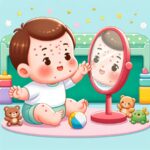Urticaria, widely known as hives among infants, presents a puzzling and often distressing scenario for many new parents. This condition, characterized by red, raised, and itchy welts on the skin, can appear suddenly and be quite alarming. Understanding Urticaria in its entirety – from its causes and symptoms to management and prevention strategies – is crucial for parents aiming to provide the best care for their little ones. This comprehensive guide offers a deep dive into the world of Urticaria (hives), providing new parents with the knowledge and tools needed to effectively address this condition.
What is Urticaria (Hives) in Babies?
Urticaria in babies is a skin reaction that leads to the development of welts that are red, raised, and incredibly itchy. These welts can appear anywhere on the body and may vary in size, from small spots to large blotches. Hives can be triggered by a variety of factors, including allergic reactions to food, medications, or other substances, infections, and even stress. While Urticaria is generally not life-threatening, understanding its causes is vital for preventing future outbreaks and managing symptoms effectively.
The exact cause of hives in infants can be difficult to pinpoint due to the wide range of potential triggers. Common allergens include certain foods, insect bites or stings, exposure to pet dander, and certain medications. In some cases, viral or bacterial infections can also lead to the appearance of hives. For more detailed information on infant allergies, click here.
How to Identify Symptoms of Urticaria in Your Child
Identifying the symptoms of Urticaria in infants is the first step towards effective management. The most apparent sign is the appearance of red, raised welts on the skin that are often itchy. These welts can appear suddenly and may spread or change shape over time. In addition to the physical symptoms, your child may exhibit signs of discomfort or distress due to the itchiness. It’s important to monitor these symptoms closely and consult a healthcare provider if hives persist for more than a few days or are accompanied by other symptoms, such as difficulty breathing or swelling.
Another key symptom to watch out for is the presence of angioedema, which is a deeper form of swelling beneath the skin. Angioedema often occurs around the eyes and lips and can lead to breathing difficulties if the swelling is severe. Keeping a close eye on these symptoms and understanding when to seek medical attention is crucial for the safety and well-being of your baby. For guidance on managing Atopic Dermatitis, another common skin condition, click the link.
Effective Strategies for Treating and Managing Urticaria in Infants
The treatment and management of Urticaria in infants primarily focus on relieving symptoms and preventing future outbreaks. In mild cases, home remedies such as applying cool, wet compresses to the affected areas can provide significant relief. Antihistamines may also be recommended by your healthcare provider to help reduce itching and swelling. It’s essential to consult a pediatrician before administering any medication to your baby, as dosages and formulations differ from those for adults.
In addition to medication, identifying and avoiding triggers is a critical component of managing Urticaria effectively. Keeping a detailed diary of your baby’s diet, environment, and any products used on their skin can help identify potential allergens. In cases where a specific allergen is suspected, your healthcare provider may recommend allergy testing. For comprehensive insights into managing eczema, another skin condition that affects infants, visit our detailed guide.
When to Seek Medical Advice for Urticaria in Babies
While Urticaria often resolves on its own, there are certain situations where seeking medical advice becomes imperative. If your baby exhibits signs of severe allergic reaction, such as difficulty breathing, swelling of the face or lips, or if the hives are accompanied by fever, immediate medical attention is required. These symptoms could indicate a more serious condition such as anaphylaxis, which is a medical emergency.
In addition, if hives persist for more than a few days without improvement, or if your baby appears to be in discomfort, consulting a healthcare provider is advisable. They may suggest further testing to rule out underlying conditions or allergies. For concerns related to food allergies, which are a common trigger for Urticaria, consult our comprehensive resource for more information.
Understanding Urticaria (hives) in babies is crucial for new parents looking to provide the best care for their little ones. By recognizing symptoms early, identifying and avoiding potential triggers, and knowing when to seek medical advice, parents can effectively manage this condition and ensure the comfort and well-being of their child. For more valuable insights and resources on infant health, visit our dedicated section on Urticaria (hives).













